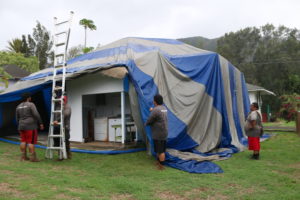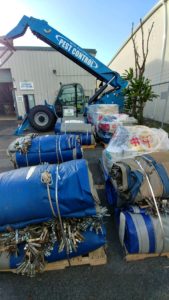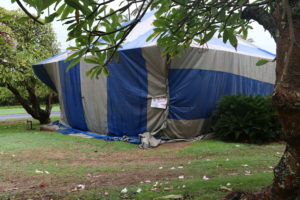Looking for Access?
Cur nutrix cantare?Est camerarius accentor, cesaris.Eposs sunt solems de varius liberi.
Register TodayCur nutrix cantare?Est camerarius accentor, cesaris.Eposs sunt solems de varius liberi.
Register TodayCur nutrix cantare?Est camerarius accentor, cesaris.Eposs sunt solems de varius liberi.
Login NowEvery structural fumigation begins with a plan, but not many require two people and four days. Read why this job in paradise required so much planning detail.
The job was to fumigate almost 100 structures totaling 4.6 million cubic feet within a two-week period at a job site 1,000 miles away. The Vikane® gas fumigant needed was at a distributor location 300 miles from the job site, and the only way for Mid-Pacific Pest Control to get there would be by a barge that was leaving in nine days. Miss the deadline and the next barge would not be leaving for two years.

The fumigation was necessary to stop drywood termite damage to structures at the Kalaupapa Leprosy Settlement and National Historic Park on the island of Molokai in Hawaii. Mid-Pacific is based on Maui, about 1,000 miles away by air, and the Vikane needed for the job was 300 miles from the job site on Molokai.
The essential tool to make all this happen was six large dry-erase whiteboards, says Alex Redeker, vice president of Mid-Pacific Pest Control, Wailuku, Hawaii.
“Two of us took close to four days to map out everything we would need on the whiteboards.” Redeker says. “I had taken a gamble on this job by flying to the site several months before to measure the buildings and see exactly what was needed. Investing in that site visit helped us plan out in detail the logistics for the equipment needed to do everything the label required, meet park service requirements and do the job safety requirements, including bringing OSHA-required electrical and fall protection. We mapped out steps needed to get permit approvals. Our planning even included the food menu for seven guys for two weeks.”
The immediate need was to arrange shipping of 2,900 pounds of Vikane. The fumigation contract with the U.S. National Park Service was signed June 15, and two barges, one a hazmat barge, would be leaving June 24 to make the trip to Molokai. Mid-Pacific had arranged with distribution to hold the Vikane in reserve in hopes of getting the contract, and as soon as that happened they moved quickly to get the necessary permits to meet the tight shipping deadline.

This would be Redeker’s third trip in recent years to fumigate structures at the leper colony. The site is a virtual paradise for drywood and subterranean termites — a peninsula cut off from the rest of the island by vertical, 2,000-foot-high mountains and surrounded by dense forest. The conditions for a fumigation are trying. Salt air has corroded some of the metal roofs. Some buildings were covered in moss. Winds often ranged between 30 and 40 mph. And when Mid-Pacific arrived on-site in mid-October, it rained every day.
Several things had changed since Redeker’s last fumigation. With fewer than a dozen aged patients now remaining at the leper colony, the state department of health could no longer justify maintaining essentially a small city of some 200 structures. One of the cost reductions would be having barges come only once every two years instead of every year to bring necessary supplies.
State maintenance obligations also are being reduced by transferring ownership of many non-health-care-related buildings to the National Park Service, which in turn contracted with Mid-Pacific to preserve the historic structures. This transition meant Mid-Pacific needed to comply with both state health department and federal park service requirements.
“One of the health department restrictions is that visitors can’t stay more than six days at a time,” Redeker says. “So, we had to get special approval to stay a couple of days longer. What we ended up doing was working eight days on, returning home for a week to give our guys a break, and then returning for another eight days to finish the work.
“This time the health department also required that we bring in all our own food. In the past we had been allowed to eat in the cafeteria, but since our last visit, that building had burned to the ground. So, we brought in our own food and prepared it ourselves. You are not allowed to hunt or fish, but a few times the state workers would bring over fish they had caught to share with us, and we shared with them what we brought. We would all sit outside and eat together kind of Hawaiian-style.”
Altogether Mid-Pacific brought in 7,500 pounds of gear and supplies by air in addition to what had been shipped on the hazmat barge.
Because the hospital is restricted for department of health patients and staff only, Mid-Pacific contracted with an aviation company on Maui to have a plane on standby in case someone on their crew became sick or was injured.
Fumigation work was done from Oct. 23 through 30, with the crews then returning home for a week. They returned to work from Nov. 7 to 14. The National Park Service wants to renovate as many structures as possible as fast as possible. On this trip, Mid-Pacific fumigated 94 structures, some full buildings and some structures with just three sides and a roof.

Because winds on Maui can often be 30 to 40 mph, Mid-Pacific uses heavy 50-by-75-foot tarps weighing 285 pounds each and designed to withstand 55 pounds of force per square inch. Tarps are tied down on the roof and at ground level. Mid-Pacific was signed off to use a park service tele-handler after its operators — who used the company’s own tele-handler on Maui — had demonstrated they knew how to operate it properly.
Mid-Pacific also installed subterranean termite bait stations to protect buildings being attacked by subterranean termites, mostly Formosan termites.
The first was a 140,000-cubic-foot museum containing rare artifacts, such as a Hawaiian coin discovered on-site that dated to before the settlement began, plus paintings, patient interviews, death records and more — essentially the entire history of the leper colony.
“One of the archeologists in the museum had never been involved in a fumigation and wanted to stop it out of concern for the contents. So, we had to sit down and explain that it was not going to be a problem,” Redeker says. “Wes Otani, our Douglas Products sales rep, had been with us the first week to do a Quality Assurance Review, which helped reassure the park service that everything was being done properly. So, when the museum manager needed information, we used a satellite phone to call Wes. It took three calls to answer all the technical questions. It delayed fumigation of the building, but we were able to get it done. When we cleared the building we not only found dead drywood termites but also about 50 dead rats.”
The other building posed more of a problem, the Saint Philomena Catholic Church where Father Damien ministered. To fumigate it, a rock wall would need to be moved one foot. But before anything at the site could be disturbed, regional park service approval was needed. That had not been gained, so the church cannot be fumigated until next year.
“Our planning included a contingency for something like this. The good news is that we have enough Vikane on the island to fumigate the church next year,” Redeker says. “Fortunately, the federal government operates a hazmat storage site on the settlement where we can store the cylinders of Vikane. To prevent saltwater damage to the cylinder bonnets, we taped each one. And Douglas Products worked with us on all this because all the empty cylinders will now have to sit there until the next hazmat barge can make the next round trip.”
“On a job like this you have to plan for the worst but hope for the best,” Redeker says. “You can‘t just go get something that you need all the sudden. So, you need to bring redundant scales, extra SCBAs and extra Spectros units for clearing. But after planning and doing a job like this successfully, I believe we could go anywhere in the world to do a fumigation.”